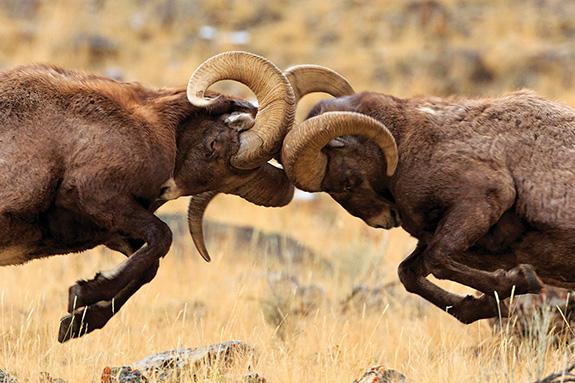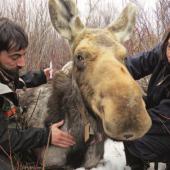Rights & Ritual
Montana's rutting bighorn rams.
A triple-thick skull structure to protect the brain during collisions at 20 miles per hour, massive horns weighing up to 30 pounds, and a body weight that can exceed 300 pounds: Montana’s Rocky Mountain bighorn rams are built for violent, prolonged battles to establish dominance and breeding rights to the herd’s females.
What few people realize is that as the rams’ late-November breeding season approaches and testosterone levels climb sky-high, these magnificent animals avoid violent confrontations with each other a majority of the time. According to wildlife experts, during the roughly mid-October to mid-November “pre-rut,” bighorn rams settle most rivalries non-violently, at least on a temporary basis. Like a society of ancient warriors, males use ritual-like behavior to determine position in the group until, in some circumstances, battle becomes inevitable.
Why would bighorns avoid fighting when they are designed for all-out, head-on combat? Biologists believe that for rams, avoiding unnecessary battles during the weeks leading up to breeding is an adaptive evolutionary behavior that is important to survival. As one Yellowstone naturalist explains, “A fight between rivals can continue for hours, and the rams expend a tremendous amount of energy that they can’t afford to waste when the harsh Montana winter is imminent. Head-on collisions can cause serious injury and even death to the combatants. The impact is so powerful that it produces a sound—a kind of bony ‘thwock’—that can sometimes be heard at a distance of a mile or more.”
In Montana, beginning in mid-October, a herd’s mature rams gather up and engage in numerous nonviolent interactions with one another to establish and maintain hierarchy. One frequently seen behavior is two rams standing side-by-side, pressed closely together. It’s believed that the rivals are comparing horn size to assess size and strength without a physical fight.
The interaction usually ends with the smaller-horned ram backing off, and in this way the standing of the two males is established for a time. The less-dominant animal may rub against the hormone secreting areas of the more powerful animal before moving away, and biologists suggest that the purpose is to take on the scent of the dominant male. Each ram has an organ behind its lip that becomes enlarged and serves as a sensor for the hormones released by other bighorn sheep.

The group of rams also engages in other repetitive, non-injuring behavior such as pushing, kicking, jostling, and short charges, and like middle-school rivals, these males seem both agitated by and obsessed with one another. In the end, the large number of nonviolent interactions is believed to reduce the number of violent battles that would otherwise take place to establish dominance in breeding.
Bighorn sheep horns are not shed; instead, they continue to grow in length for years, and after reaching maximum length, they continue to expand in diameter. With a little practice, you can determine a mature male’s age by the ridges, or rings, on its horns.
A bighorn ram gains full maturity at four years of age, and will at that time have a distinct, half-inch-wide, horizontal ridge around each horn right about ear level. The part of the horn that extends from ear level to the tip grew before the ram was four, while the part of the horn that extends to the skull grew after the ram was four.
To age a bighorn, count the number of prominent horn ridges between the ear and the skull (prominent ridges are separated by thinner ridges). For Montana’s Rocky Mountain bighorn rams, a prominent ridge is created each year during late fall, when food is scarce and, in addition, the stress of rut causes males to spend less time eating. So, a bighorn ram with four prominent ridges between the four-year age marker and the skull is about eight years old.
Counting Sheep
Gallatin Canyon is a great place to spot bighorns, as is Big Sky. Just after the turnoff from Hwy. 191 to the Meadow Village, keep your eyes open. On the north side of the road, bighorns are often seen grazing the hillside or licking salt off the pavement.
In Yellowstone Park, watch for sheep on the cliffs and crags above the Gardner River Canyon between the north entrance and Mammoth, and on cliffs along the Yellowstone River. Outside the park, look along the highway corridor between Gardiner and Livingston.
For other locations, check the Montana FWP website at fwp.mt.gov for current bighorn-sighting information and species facts. Inside Yellowstone, check at visitor centers, with park staff, and online at nps.gov/yell. Remember to keep a minimum of 25 yards between yourself and these animals. Your behavior makes a difference in the ability of wildlife to survive the approaching winter months. —BARBARA LEE













